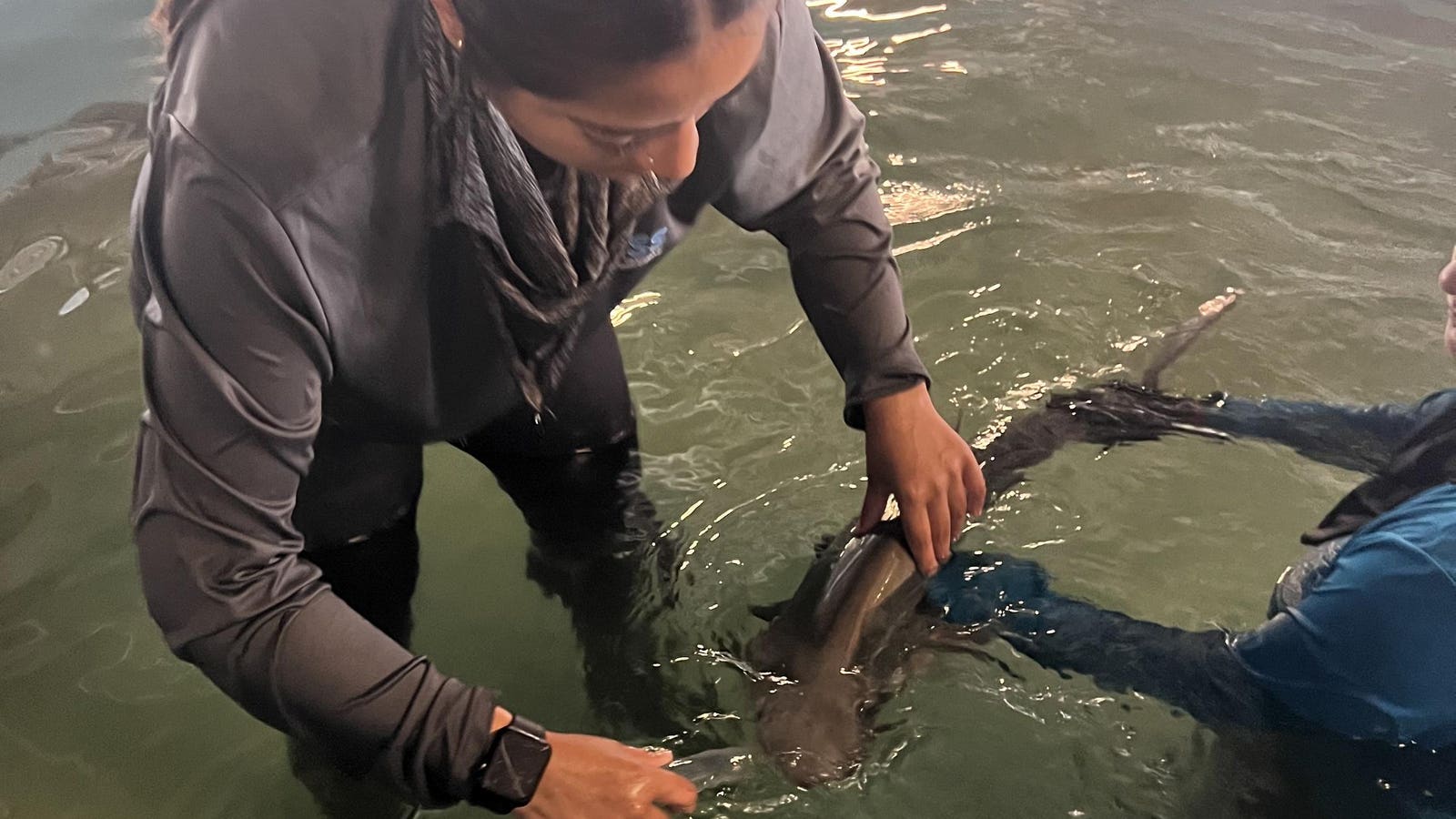Grace Solevilla-Moreno handling a shark used in one of her recent projects.
Provided by Grace Solevilla-Moreno for use by Forbes
Many picture a straight line when imagining the path to becoming a marine scientist: bachelor’s, master’s, and then a PhD to finally earn the coveted “Dr.” title. But science, much like the ecosystems it studies, thrives on complexity, detours, and the small forces that shape the bigger picture. Researcher Grace Solevilla-Moreno is proof of that. “I actually started in psychology,” she said. “I earned my B.S. in psychology and work as a paraeducator at a nearby high school. Before becoming a paraeducator, I worked in mental and behavioral health. [But] I realized I needed a career that involved the outdoors.” Her journey unfolded through what might have seemed like small steps at the time, from a California Naturalist certification to online events during the pandemic, and together they built momentum, leading to the pivotal moment when she found Minorities in Shark Sciences. “MISS gave me a safe, welcoming space,” she said. “I started attending virtual events where I felt safe, welcomed, and valued by the community. I eventually applied for travel funding where I attended my first scientific conference [and] this set me on a path to begin research in sensory biology.”
Sharks had always captured her imagination, but it wasn’t just their size or power that fascinated her. It was the tiny, often overlooked cellular details that reeled her in. Once she entered research, Solevilla-Moreno became fascinated with shark health at the microscopic level, drawn to looking at sharks in a way most people don’t see. Her most recent project involved searching for parasites in shark blood, small, often hidden elements with big implications for understanding their wellbeing; parasites, it turns out, give us a window into shark health, telling us how strong or weak a shark’s immune system might be, and whether environmental stressors are making them more vulnerable. In other marine animals, parasites can have profound effects. For example, blood flukes in sea turtles can lead to range of inflammatory reactions in their vascular system severe enough to strand or kill them. In fish, trypanosomes can reduce fitness and make them more susceptible to other diseases (which can kill them). So, if we pay attention to parasites in sharks, she hopes might find similar patterns that connect their health to what’s happening in the ocean since they can also act as ecological trackers. Some parasites are host- or region-specific, which means their presence can give us clues about where a shark has been or what it’s been eating. That connection between parasites and environment is what excites her most.
“I have been looking at blood flukes in shark hearts and for trypanosomes in their blood,” she said. “I had to teach myself the techniques — like preparing blood smears and using the Giemsa Wright Stain — to see the cells properly. I can’t yet conclusively say I found trypanosomes, and none of the hearts I dissected had blood flukes. My theory is that because these were young-of-year sharks, they hadn’t been exposed to parasites in their environment yet.” While the absence of parasites may sound uneventful, that absence tells us something too: it gives a baseline for what a healthy, parasite-free shark looks like at an early age. As sharks grow and move through different habitats, they encounter new hosts and environmental conditions, and that’s when parasites begin to appear. Tracking these changes over time helps us understand how immune systems develop, how sharks interact with their ecosystem, and even how environmental stressors — like pollution or climate change — may make them more susceptible to infection. When we look at patterns across multiple sharks, we start to see how populations respond to environmental pressures. Parasites (or their absence) become indicators of ecosystem health, revealing hidden connections between species, habitats, and human impacts.
While it might seem counterintuitive, having few or no parasites can actually signal problems in an ecosystem. Parasites are found throughout our natural world and occur in nearly every major animal group. In fact, ecosystems with diverse wildlife often support a wide variety of parasites, because these organisms rely on specific hosts to survive! When human activities like pollution disrupt habitats, these delicate host–parasite relationships can break down. Many parasites also require multiple hosts to complete their life cycles, so their presence and/or absence can reveal a great deal about the health and complexity of an ecosystem. While shark biology and ecology have been researched for decades, parasite-focused studies for these animals have historically been limited. This field of research is still emerging… and there’s so much we don’t know.
Grace Solevilla-Moreno using electronic pipette for competitive ELISA at New College Florida, Sarasota, Florida, USA.
Provided by Grace Solevilla-Moreno for use by Forbes
Just as these tiny parasites reveal hidden truths about sharks and their environments, Solevilla-Moreno sees the importance of visibility and representation in science, showing that even small, often overlooked voices can have a big impact. Beyond the lab, she is deeply committed to mentorship and representation; her identity as a Latina scientist is something she carries proudly into the field. For her, representation isn’t just symbolic — it’s about shifting culture. “To bring my Latinidad into this space means to take up space as a younger woman of color. Historically, we have been made to shrink ourselves because society attempts to humble ambitious women,” she said. “No woman should have to dim her light in order to make other people comfortable. Being brown in this space means representation for others, it means I am just as capable as anyone else no matter what shade I am.”
The Hispanic population in the United States has grown rapidly in recent decades, and more Hispanic students are attending college than ever before. Yet despite this growth, Hispanic Americans remain underrepresented in science, technology, engineering, and mathematics (STEM) careers. Latina women specifically remain significantly underrepresented in STEM fields, only holding 2% of STEM jobs in the U.S., facing compounded disparities as both women and ethnic minorities. Systemic barriers (such as cultural expectations, limited mentorship, and restricted access to advanced educational opportunities) continue to hinder their participation and advancement. These gaps highlight the ongoing need for targeted initiatives in mentorship, education, and career support to improve the representation and success of Latina women in STEM. Yet Solevilla-Moreno is hopeful, seeing a future where more Latine scientists lead shark research and conservation projects, serving as stewards of the ocean and incorporating culture into their research, especially if they are from Indigenous communities. “As researchers become increasingly aware about integrating Indigenous knowledge, I hope to see more of these approaches in marine science. I envision more Latine scientists leading projects and serving as primary investigators as people become the first in their families to pursue postsecondary education.”
For now, she’s focused on completing her first semester of graduate school, the first in her family to pursue an advanced degree. It’s a milestone that feels both personal and communal. “It’s a big step for me and my family,” Solevilla-Moreno said, explaining she wants her graduate work to combine shark science with environmental education, making marine research more accessible for young people. “I want underrepresented students to know that asking for help isn’t weakness. We’ve been taught to carry everything alone, but we’re stronger together. MISS showed me that, and I hope to pass it on.”









